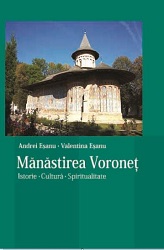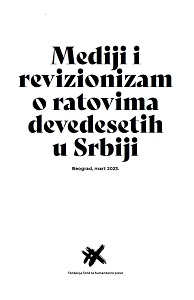
We kindly inform you that, as long as the subject affiliation of our 300.000+ articles is in progress, you might get unsufficient or no results on your third level or second level search. In this case, please broaden your search criteria.


Education tolerance, respect for other cultures and ethnicities is a primordial bridge in building a democratic society. Both in education and in the social environment there are serious gaps in addressing diversity, which is based mainly on stereotypes. This problem occurs including the lack of a scientific and methodological support in addressing teaching and teaching ethno-cultural diversity. EU experience shows that namely through research and the sharing of ethnicities co-existing in Member States and many European nations can be overcome inter-ethnic conflicts and can contribute to the prosperity of communities and states.
More...



Ovaj moj rad bavi se “zemljicom Bosnom”, odnosno značenjem sintagme “το χωρίον Βόσονα” u djelu “De administrando imperio” Konstantina VII. Porfirogeneta. Car-pisac tu navodi sintagmu u poglavlju o Srbima - pošto je spomenuo šest “naseljenih gradova” u pokrštenoj Srbiji, pridodaje da se “zemljica Bosna nalazi unutar pokrštene Srbije”, te onda imenuje dva grada u njoj. Riječ “χωρίον” je u središtu naše analize - uglavnom se u literaturi prevodi kao “zemljica” ili sličnim izrazima, ali takav prijevod i dalje izaziva dvojbe.
More...
Neben Populär- und Fachliteratur, Rundfunk, Film, Fernsehen, Theater und moderner elektronischer Medien stellen die Museen eine der Methoden und Mittel für die Vermittlung des historischen Wissens dar. Im Unterschied zu anderen Medien beinhalten die Museen dreidimensionale Objekte als ihren wesentlichen Bestandteil und ihre Eigenheit. Daraus ergeben sich mediale Vorteile, aber auch manche Schwierigkeiten, die allesamt in dem mittlerweile weit entwickelten Fach Museologie kontrovers diskutiert werden. Die Museen sind ein Phänomen der abendländischen Kulturgeschichte. Ihre Ursprünge liegen in der Beschäftigung der Humanisten mit der Antike und später in den Schatz- und Kuriositätenkammern der europäischen Adligen und Herrscher. Während der Aufklärung im 18. Jahrhundert und insbesondere im Laufe des 19. Jahrhunderts, als die Idee der Bildung stark an Bedeutung gewann, wurden die Museen immer mehr zu Bildungsanstalten. Aus dieser Zeit stammt auch die Idee des Franziskaners Ivan Franjo Jukić von der Gründung eines bosnischen Museums, die erst im Jahr 1888 mit der Errichtung des Landesmuseums in Sarajevo verwirklicht werden konnte. Jukićs Vorhaben war allerdings mehr von nationalen und patriotischen als von bildungsaufklärerischen Motiven geleitet. Seine Vorstellung vom Museum entsprach mehr der eines “Tempels” der (nationalen) Musen als der einer Lehrstätte. Die Dichotomie “Tempel” oder „Lernort“ kennzeichnet die Diskussion um Sinn und Zweck der Museen bis heute. Die jeweiligen Positionen werden am deutlichsten an dem Streitpunkt sichtbar, wie museale Gegenstände in Dauer-, Wechsel- oder Spezialaustellungen präsentiert werden sollen. Damit im Zusammenhang steht auch die Frage, was als “museal” und damit sammlungs- und erhaltungswürdig gilt. Als Attribute der musealen Gegenstände werden im allgemeinen Alter, Seltenheit bzw. Originalität und materieller/ideeller Wert bzw. Kostbarkeit angesehen. Jedoch sind all diese Merkmale relativ und unterliegen den museumstheoretischen- und ideologischen Wandlungen, wie das am Beispiel des Attributs Originalität zu zeigen versucht wird. Die Auffassung der Museen als “Tempel” legt Wert auf “Originalität” der Exponate. Wenn diese jedoch als “Lernorte” verstanden werden, tolerieren, ja postulieren sie die Einsetzung von Kopien, Repliken, Duplikaten, Rekonstruktionen und Inszenierungen. In diesem Fall wird die Didaktik besonders groß geschrieben; was dieses Problemfeld betrifft, so stehen den statischen musealen Darstellungen des 19. Jahrhunderts die dynamischen Präsentationen des 20. und 21. Jahrhunderts gegenüber. Die Museumsdidaktik ist mittlerweile als eine selbständige Disziplin etabliert und ist aus der Museumsarbeit nicht mehr wegzudenken. Ob Originale oder Kopien, ob statische Ausstellungen oder dynamische Inszenierungen – in all diesen Fällen werden in Museen Gegenstände gezeigt, die aus ihrem ursprünglichen Kontext herausgerissen wurden. Dadurch verlieren sie manches von ihrer “Aura” (Walter Benjamin), werden aber gleichzeitig durch entsprechende Darbietung zu symbolhaften Objekten und “Semiophoren” (Krzysztof Pomian), d. h. Zeichenträgern. Der Beitrag berücksichtigt in erster Linie die deutschsprachige Literatur über Museologie und stützt sich zum großen Teil auf die Museumspraxis des Autors in deutschen Museumseinrichtungen. Besonderes Augenmerk wird dabei den kleinen Museen und lokalen oder regionalen Museumssammlungen gewidmet, denn in der Vermittlung historischen Wissens spielen gerade diese eine besondere Rolle. Zum Schluß werden einige Überlegungen angestellt, wie das Ahdname als zentrales historisches Dokument des Franziskanerordens in Bosnien und des bosnischen Katholizismus museal präsentiert werden könnte.
More...
Plato counted the farmer-philosopher Myson of Chen among the Seven Sages of Greece, and the Oracle of Delphi declared him one among the wisest of all Greeks. Yet very few traces of his thought survive. Among these rare fragments, one confirms his wisdom: “We should not investigate facts by the light of words, but words by the light of facts.” More than to philosophers, Myson’s maxim ought to be suited to historians, who study the genesis and development of past human experiences, which almost always entail new words and concepts—hence new arguments. These new words are used by the people directly affected in order to name and describe their experiences, and later to pass them down to posterity.
More...
Stalin’s macabre figure has long been a model for the interpretation of the phenomenon of totalitarianism, and of the role that its founders and leaders played in it. For quite some time, starting with the classic works of Hannah Arendt and the other seminal authors of the theory of totalitarianism, this interpretation matured within the confines of the totalitarian paradigm.
More...
The Stalinist period is the last phase of Soviet history that may be studied with the contribution of significant, if sometimes limited or patchy, archival resources. Investigations carried out from archival records in recent years have yielded remarkable results. The outpouring of information, consisting of previously unpublished documents and research material, has been so profuse that even specialists are finding it hard to keep up. Indeed, the opening of the archives has spurred a change in methodological approaches.
More...
As his works prove, and as those who knew him remember, Victor Zaslavsky was sensitive with regard to the “national question” in the USSR. Nor could it have been otherwise, given the part this question played in his life. After the war, his mother, a medical officer in Leningrad during the Nazi siege, endured persecution in the dark season of Stalinist “anti-cosmopolitanism.” And he too was barred from carrying out the studies he loved because he was a Jew. Later, his deep knowledge of the country and its diversity—made possible by his work as a mining technician, which he had been forced to pursue because of the barriers placed on his desired path—strengthened his awareness of the importance of the “national question” in the USSR. At the time, a large part of Europe’s left, as well as many specialists of Soviet history and society, preferred to underestimate this issue, or to ignore it altogether.
More...
The Katyn case has haunted the post–World War II bilateral relations between Russia and Poland, affecting the two countries in different ways. This chapter does not describe the events of Katyn historically,but rather analyze the Katyn discourse or, more precisely, how the issue has been described, internalized, and dealt with in Russia since World War II to the present. I take into account both the macro structure and broader context—that is, the general discourse on Katyn—as well as a number of sublevels (namely, stratifications and specific discourses through which the issue has been articulated in the course of the years).
More...
2008 was a year of a lively discussion on ways to commemorate and present the common Polish-German history both in Poland and Germany. It was triggered by the government of the German Federal Republic which undertook steps to determine how to commemorate the forced resettlement of Germans after the Second World War, and proposed the “Visible Sign” Centre Bill to regulate the foundation and status of the memorial against the flight and expulsion (Sichtbares Zeichen gegen Flucht und Vertreibung).
More...
The collection contains articles from the round table dedicated to the women’s writing issues which took place at the end of 2015 at Southwest University “Neofit Rilski”, Bulgaria. The papers are reviewing the woman in different creative roles – as an author, translator, critic, character. They analyze the variability of the perceptions towards women’s writing in the course of different historical periods. In the texts stand out various perspectives of the woman as an object of literature; a righteous virgin/wife, an innocent martyr or an audacious emancipator.
More...
Autorka tej książki jest psychologiem społecznym. Fascynacja konstruktem miejsca nie przysłoniła jej jednak głęboko zaszczepionego przekonania, że rolą nauki jest wykrywanie zależności i mechanizmów, a nie jedynie opis faktów. Fenomenologiczne opisy miejsc powinny zatem stanowić punkt wyjścia dla głębszej analitycznej refleksji nad prawidłowościami, których jednym z członów jest właśnie miejsce i jego cechy. Treść tej książki jest zatem swoistą hybrydą - próbą podsumowania wielowątkowych, również jakościowych, badań nad miejscem i jego rolą w życiu człowieka, próbą dotarcia do pewnych ”uniwersaliów miejsca„, które będzie można potraktować jako zaczyn ”teorii miejsca„, a także podsumowaniem ”pozytywistycznego„ dorobku badań, prowadzonych przez autorkę oraz jej studentów i doktorantów w ramach Pracowni Badań Środowiskowych, dotyczących związku człowieka z miejscem, jego przyczyn, konsekwencji oraz postaci, jakie może przybierać we współczesnym globalizującym się świecie.
More...




The publication is the first comprehensive study of history and historical architecture of Warsaw University buildings located within Krakowskie Przedmieście and Oboźna Streets and the Visitationist Church adjacent to them. This unique urban development was created in the place of the former residence of the Vasa royal dynasty (the 17th century), expanded and transformed into the Warsaw Corps of Cadets (2nd half of the 18th century), and finally into the university campus (the 19th century).The authors talk about the complex history of the Warsaw Alma Mater in several richly illustrated chapters devoted to historic buildings, focusing not only on architecture, but also on the figures of professors and alumni of the University – eminent representatives of Polish science and culture.
More...